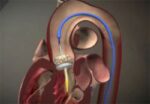Original title: Comparison of Results of Transcatheter Aortic Valve Implantation in Patients with Severely Stenotic Bicuspid versus Tricuspid or Non-Bicuspid Valves. Reference: Charis Costopoulos et al. Am J Cardiol. 2014 Jan 31. pii: S0002-9149(14)00554-2. The bicuspid aortic valve (BAV) is the most common congenital cardiac malformation. It occurs in approximately 1% of the general population and often<a href="https://solaci.org/en/2014/03/11/n-4327/" title="Read more" >...</a>
Aortic regurgitation: the best predictor of post TAVI mortality
Original title: Post-procedural aortic regurgitation in balloon-expandable and self-expandable TAVR procedures: analysis of predictors and impact on long-term mortality: insights from the FRANCE 2 registry. Reference: Van Belle E et al. Circulation. 2014; Epub ahead of print. This study used transthoracic echocardiography (TTE) to evaluate 2769 patients undergoing successful TAVI in 34 centers in France, enrolled in<a href="https://solaci.org/en/2014/03/06/n-4313/" title="Read more" >...</a>
What is the contrast media dosing that predicts acute kidney injury after TAVI?
Original title: Renal Function-Based Contrast Dosing Predicts Acute Kidney Following Trancatheter Aortic Valve Implantation Reference: Masanori Yamamoto, et al. J Am Coll Cardiol Intv 2013;6:479–86. Acute kidney injury (AKI) presents in 10 to 30% of patients undergoing TAVI; it is associated to the increase of morbidity and mortality and it prolongues hospitalization. This study included 415 patients with<a href="https://solaci.org/en/2013/06/05/n-2668/" title="Read more" >...</a>
QRS after TAVI, The Best Predictor for safe transitory pacemaker removal
Original title: Patients Without Prolonged QRS After TAVI with CoreValve Device do not Experience High-Degree Atrio-Ventricular Block. Reference: Gauthier Mouillet et al. Catheterization and Cardiovascular Interventions 81:882–887 (2013). High degree atrioventricular block (AVB) in the context of transcatheter aortic valve implantation (TAVI) has been reported with variable incidence (3-45%) depending on the population characteristics and the kind of<a href="https://solaci.org/en/2013/05/30/n-2766/" title="Read more" >...</a>
The need for pacemaker post TAVI does not change the prognosis
Original title: Impact of Permanent Pacemaker Implantation on Clinical Outcome Among Patients Undergoing Transcatheter Aortic Valve Implantation. Reference: Lutz Buellesfeld et al. J Am Coll Cardiol 2012;60:493–501 Although pacemaker implantation after a percutaneous aortic valve (TAVI) implantation, constitutes a significant proportion of the complications related to the procedure, this is generally considered a benign event. This study analyzed<a href="https://solaci.org/en/2013/03/25/n-2983/" title="Read more" >...</a>
TAVI and cardiac tamponade, a rare but serious complication.
Original title: Incidence, Management and Outcomes of Cardiac Tamponade During Transcatheter Aortic Valve Implantation Reference: Ahmed Rezq et al. J Am Coll Cardiol Intv 2012;5:1264 –72 Transcatheter Aortic Valve Implantation (TAVI) for high risk patients is a valid strategy today but not without complications. Among these is cardiac tamponade, still rare but important because of its implication. There<a href="https://solaci.org/en/2013/01/23/n-3235/" title="Read more" >...</a>
Post TAVI LVEF Improvement: Only with No New Conduction Defects
Original title: Impact of a New Conduction Defect Alter Transcatheter Aortic Valve Implantation on Left Ventricular Function Reference: Rainer Hoffmann, et al. J Am Coll Cardiol Intv 2012;5:1257– 63. TAVI development in high risk patients can produce new conduction defects and require a definitive pacemaker in almost a third of treated patients. The aim of this study was<a href="https://solaci.org/en/2013/01/21/n-3221/" title="Read more" >...</a>
Transfemoral Transcatheter Aortic Valve Implantation: more experience and better results.
Original title: Trends in outcome after transfemoral transcatheter aortic valve implantation. Pooled-RotterdAm-Milano-Toulouse In Collaboration Plus (PRAGMATICPlus) initiative. Reference: Nicolas M. Van Mieghem et al. Am Heart J 2012;0:1-10. Article in press. Since its introduction in 2002, Transfemoral Transcatheter Aortic Valve Implantation (TAVI) has turned into a viable and safe strategy to treat patients with severe acute stenosis and<a href="https://solaci.org/en/2013/01/15/n-3193/" title="Read more" >...</a>
Aortic insufficiency has a poor prognosis in TAVI.
Original title: Impact of Post-Procedural Aortic Regurgitation on Mortality Alter Trancatheter Aortic Valve Implantation Reference: Kentaro Hayashida, et al. J Am Coll Interv 2012;5:1247-56 Transcatheter aortic valve implantation (TAVI) sprung up as a valid strategy to treat patients with severe high risk AS (aortic stenosis). However, residual aortic regurgitation (post AR) and post-dilation remain unsolved. Between October 2006<a href="https://solaci.org/en/2013/01/15/n-3200/" title="Read more" >...</a>
The largest published series of valve-in-valve with Core Valve, (Medtronic).
Original title: Valve-in-Valve Implantation of Medtronic CoreValve Prosthesis in Patients with Failing Bioprosthetic Aortic Valves. Reference: Axel Linke el al. Circ Cardiovasc Interv. 2012;5:689-697. This study evaluates the safety, feasibility and results of Core Valve implants on patients with bioprostheses dysfunctional by stenosis, insufficiency or a combination of both. Biological prostheses are preferred over mechanical ones for patients<a href="https://solaci.org/en/2012/11/02/the-largest-published-series-of-valve-in-valve-with-core-valve-medtronic/" title="Read more" >...</a>









